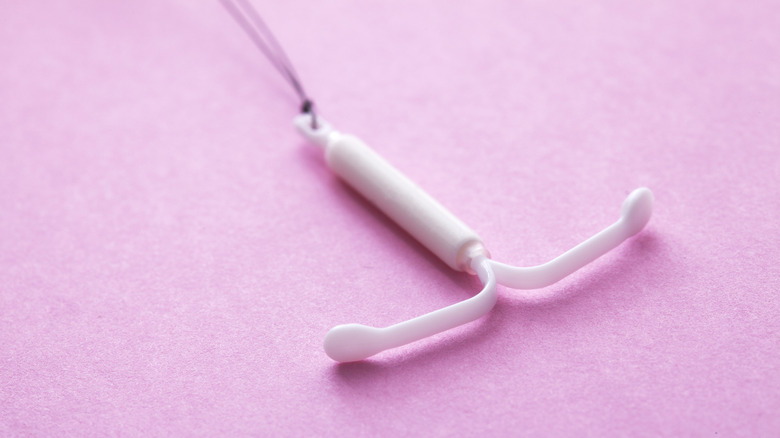The Side Effects You Might Experience If You Use The Mirena IUD
For people with uteruses, staying aware of reproductive health is an important part of taking care of themselves holistically. Getting regular pap smears, STD tests, and visiting the OB/GYN for any issues are all great ways to get into a medical care routine, per Embry Women's Health. If you have a uterus, you also might want to learn about your birth control options.
According to Planned Parenthood, if you are sexually active but don't want to become pregnant, there are a myriad of contraceptive options that can prevent that from happening. The organization shares that, between birth control pills, patches, and more, there's a wide range of birth control methods available, many of which have high efficacy rates. One of the highest, the intrauterine device (or IUD), has a rate of over 99% effectiveness — meaning that people who use them properly have less than a 1% chance of getting pregnant, per WebMD.
The IUD is a form of birth control that is inserted by a medical professional into the uterus in order to prevent pregnancy, per Healthline. It is a small plastic device that is shaped like a "T," and protects the eggs from being fertilized by incoming sperm — thus preventing pregnancy. According to WebMD, Mirena, a hormonal IUD, is one of the most popular options in the country, and has some important side effects to note if you're weighing options.
This IUD option has some common side effects
There are five different IUD options available in the United States, according to WebMD: The Liletta, Kyleena, Skyla, Mirena, and ParaGard IUDs. All of these options, except the ParaGard, are hormonal IUDs.
According to Planned Parenthood, the four hormonal options use the hormone progestin in order to prevent pregnancy. Mayo Clinic shares that progestin works as a contraceptive hormone by partially suppressing ovulation, thickening the mucus inside the cervix to prevent incoming sperm from reaching the eggs, and thinning the uterine lining. Each hormonal IUD is different in the length of time it can be kept in the uterus, and which patients they are recommended for.
Like any other form of birth control, the Mirena IUD has a number of possible side effects, many of which show up differently from person to person, per Healthline. Because of the progestin, there are certain side effects that are unique to the hormonal IUDs — including the Mirena.
For example, according to Planned Parenthood, side effects of the Mirena IUD include lighter periods or no periods at all, and relief from cramping. Some possible and less favorable side effects, however, include spotting and irregular bleeding, mood changes, acne, tenderness in the breasts, and headaches.
Talking to your doctor can help you decide
As with any major medical decision, speaking with a trusted medical professional about what birth control method might be right for you is key. While other forms of birth control are also popular, Mirena has the benefit of being low-maintenance in that it is inserted once and can be kept inside the uterus for up to seven years, per Mayo Clinic. This means that if you choose the Mirena as your birth control, you'll have peace of mind knowing that you're protected from unplanned pregnancy for seven years — without needing to take a pill, shot, or inserting/wearing other methods.
It's also a good idea to prepare yourself for the procedure and temporary side effects following insertion. During the Mirena insertion, which might last a minute or two (per Healthline), it's likely that you will feel some pressure or even a pinching sensation in your abdomen. Some patients also experience cramping during the insertion, and higher pain levels than for others, which can cause sweating or nausea. The outlet reports, however, that those symptoms should usually go away within a few hours or a day.
The Mayo Clinic suggests contacting your doctor as soon as possible if you experience persistent and heavy vaginal bleeding, abdominal pain, pain during sex, an unexplained fever, severe headaches, yellowing of the eyes or skin, or unusual vaginal discharge or sores.


